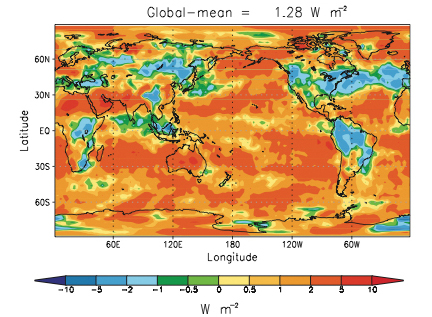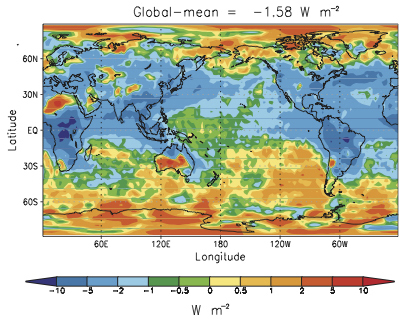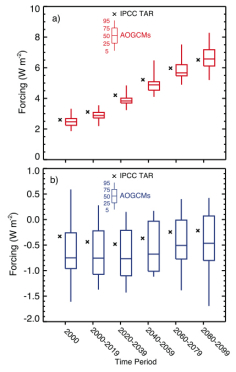Future Geographies: Radiative Forcing and the Earth's Heat Balance
The future physical geography of Earth as affected by global warming comes down to changes in the heat balance of the Earth system. Radiative forcing is a measure of the strength of agents, both natural and human, that cause climate change. Radiative forcing agents are factors that change the balance between incoming solar radiation and outgoing infrared radiation within the Earth’s atmosphere. The radiative forcing of greenhouse gases is what will propel much of this change. Documented changes with relatively high level of scientific understanding from 1750 to 2005 has been presented by the Intergovernmental Panel on Climate Change.
The Present Picture
Two long-lived greenhouse gases produced from human activities, carbon dioxide and methane, are the most potent, contributing 1.66 and 0.48 (W/m2) respectively at the global scale. Shorter-lived troposphere ozone contributes an average of 0.35 (W/m2), though we have only a medium level of scientific understanding of its contribution.

Figure 4.30 Principal agents of the radiative forcing of climate change 1750 - 2005. Courtesy IPCC (Source)
Though human activities affect agents that increase radiative forcing, they also negatively impact radiative forcing. A notable impact, is that of the aerosol content of the atmosphere. Aerosols themselves can negatively impact radiative forcing by reflecting solar radiation. But a much larger impact, and one with less scientific certainty, is their role in creating clouds which also reflect solar radiation.
In addition to changes in the gaseous composition of the atmosphere, surface albedo changes from human activities also effects radiative forcing. This is particularly true when forests are cleared for agriculture. Forests generally have a lower albedo than open land thus absorbing more incident solar radiation. These changes induce a radiative forcing by effecting the shortwave radiation balance. This is particularly true when snow is present. Open land has a more complete cover of highly reflective snow, while the lower albedo trees stand above the snow.
Natural radiative forcing largely results from changes in solar output and volcanic eruptions. As noted earlier in this chapter [link here], sunspot activity varies on an 11-year cycle. But since the dawn of the industrial age, solar output has been slowly increasing and thus the the Sun has had a positive radiative forcing effect. Volcanic eruptions produce a variety gases, though their presence in the atmosphere is relatively short lived (2 to 3 years). The most notable is sulphate aerosols injected into the stratosphere causing a negative radiative forcing. The stratosphere is presently free of appreciable amounts of volcanic aerosols. The last major eruption to affect stratospheric aerosol content was Mt. Pinatubo in 1991.
Adding the effects of other radiative forcing components like surface albedo changes, the combined net anthropogenic radiative forcing is estimated to be +1.6 (W/m2). This, according to the IPCC, indicates that since 1750, it is extremely likely that human activities have caused a substantial effect on warming Earth's climate. Additionally, is it likely that this estimate is five times greater than that which can be attributed to natural changes in the output of the Sun.

Figure 4.31a Instantaneous change in the distribution of the net radiative flux (W/m2) due to natural plus anthropogenic radiative forcings between the years 1860 and 2000 at the tropopause. Courtesy IPCC (Source)

Figure 4.31b Instantaneous change in the distribution of the net radiative flux (W/m2) due to natural plus anthropogenic radiative forcings between the years 1860 and 2000 at the surface. Courtesy IPCC. Courtesy IPCC (Source)
Figures 4.31a and b show estimates of the spatial pattern of the net radiative flux due to both natural and human factors for one particular model that incorporates the aerosol cloud albedo effect. The radiative forcing is positive for most of the earth and principally associated with long-lived greenhouse gases like carbon dioxide. This is especially true for the southern hemisphere due to the higher levels of aerosols in the source-rich continental regions of the northern hemisphere midlatitudes. Wherever high concentrations of aerosols are found, especially in the northern hemisphere, surface forcing is negative. This is due to the influence of aerosols in reducing the shortwave radiation that reaches the ground. As aerosol concentrations are lower over much of the southern hemisphere oceans and at high latitudes. With less aerosols more shortwave radiation reaches the earth thus surface forcing becomes positive.
Future Forcings
 Figure 4.32 Radiative forcings for the period 2000 to 2100 for the SRES A1B
scenario diagnosed from atmosphere/ocean general climate circulation (AOGCMs) and from the Third Assessment Report (IPCC, 2001) forcing formulas
(Top) Longwave forcing; (Bottom) shortwave forcing. Courtesy IPCC (Source)
Figure 4.32 Radiative forcings for the period 2000 to 2100 for the SRES A1B
scenario diagnosed from atmosphere/ocean general climate circulation (AOGCMs) and from the Third Assessment Report (IPCC, 2001) forcing formulas
(Top) Longwave forcing; (Bottom) shortwave forcing. Courtesy IPCC (Source)
Future heat balance conditions from the forcings is tricky and predictions from various AOGCMs do not precisely agree with one another, largely due to the radiatively active gases used, solar variability, land use change, and how radiation transfer is formulated. Figure 4.32 shows the range of forcing using "box and whisker" diagrams estimated by these models using a scenario where economic growth is rapid, world population peaks at 9 billion in 2050 and then declines, there is a quick and efficient spread of technologies, extensive social and cultural interaction occurs worldwide, and world-income and way of life converges between regions. Longwave forcing continues to increase fueling continued warming of the earth system.
Global warming will continue unabated without changes in how human activities impact radiative forcing agents. In future chapters, we'll investigate how changes in these agents will impact patterns of temperature, pressure and wind, weather, biotic systems, the hydrosphere and earth surface processes.
Assess your basic understanding of the preceding material by "Looking Back: Global Patterns and Future Geographies" or skip and continue reading.
